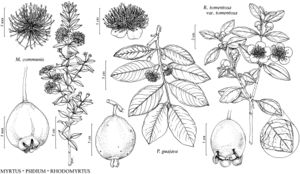Shrubs or trees to 4 m; trunk dark orangish brown, smooth or scaly, sometimes young twigs and floral disc puberulent. Leaves: blade elliptic to lanceolate, 1–3.5 × 0.3–1.8 cm, base cuneate to rounded, apex acute to acuminate, sometimes slightly mucronate. Pedicels 0.5–2.5 cm. Flowers: bud pyriform, 7–9 mm; calyx lobes ovate-triangular, 2–3 mm; petals 5–10 mm; bracteoles deciduous in very young bud, narrowly triangular, ca. 2 mm. Berries to ca. 10 mm. Seeds 3–4 mm. 2n = 22.
Phenology: Flowering spring; fruiting summer.
Habitat: Disturbed areas.
Elevation: 0–100 m.
Distribution
Introduced; Calif., La., Tex., s Europe, n Africa (Mediterranean region).
Discussion
Myrtus communis is widely cultivated and has become naturalized in San Luis Obispo and Sonoma counties in California, Caddo Parish in Louisiana, and Brazoria and Hardin counties in Texas.
Selected References
None.
Lower Taxa
None.
